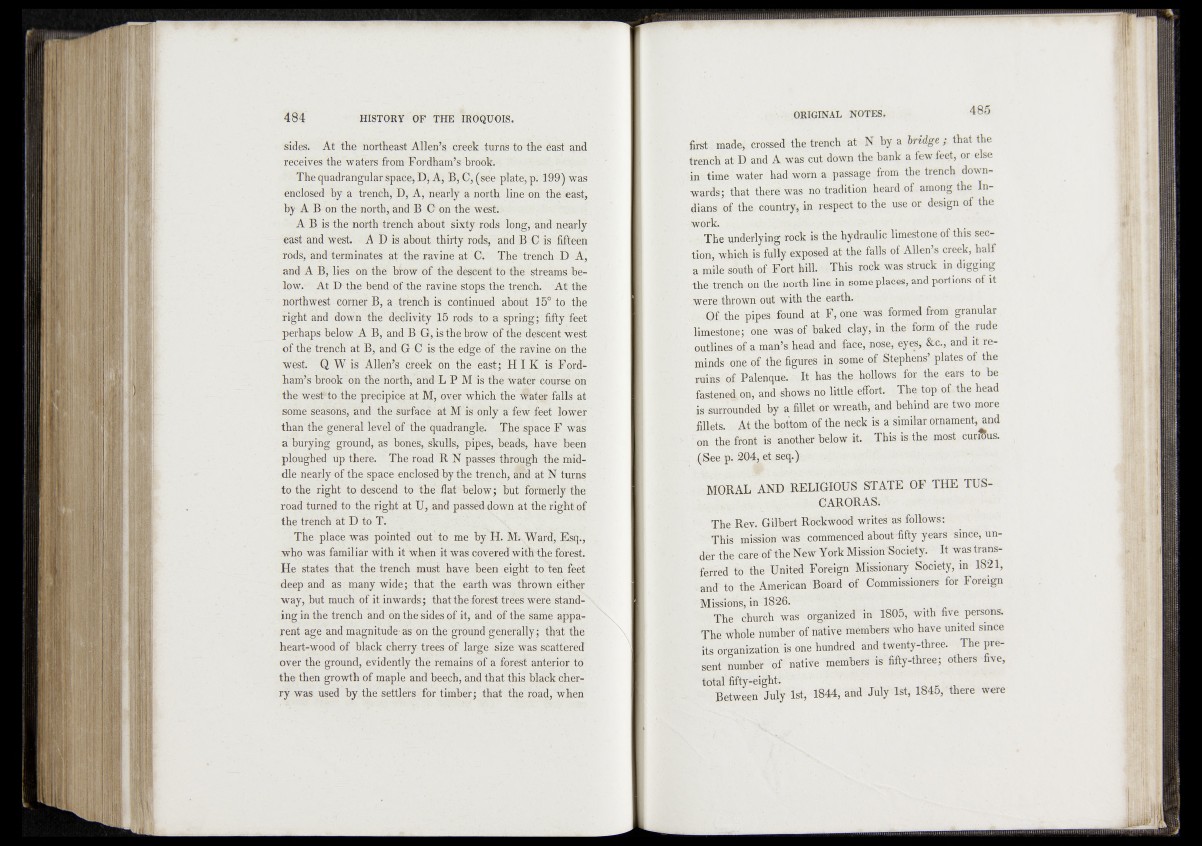
sides, At the northeast Allen’s creek .turns to the east and
receives the waters from Fordham’s brook.
The quadrangular space, D, A, B, C, (sde plate, p:_l9ft) was
enclosed by a bench, D, A, nearly a north -line on the east*
by A B on the north, aiid B O on the west;>
A B is the north trench about sixty rods long, and nearly
east and west. A D is about thirty rods, and B’_C is fifteen
rods, and terminates at the ravine at 'C." The trench I) A,
and A B, lies on the blow of the descent to the streams{ below.
At D-the bend.'of the ravine stops the trench. At the
northwest corner B, a trCnch is continued about » 15° to the
right and down the declivity 15 rods to a spring'; fifty feet
perhaps below A B, and B G, is the brow of the decent west
of the"' trench at B, and G C is the edge o f the ravine on the
west. Q W is Allen’s creek on the east; H I K is Ford-
ham’s brook on the north, and L P M ‘is the water course on
the west*to the precipice at M, oyer which the wat^- falls at
some seasons, and the surface at M is only a few feet lower
than the general level bf the quadrangle. The space F wa's
a burying ground, as bones, skulls, pipes, beads, have been
ploughed up there. The rbad R N passes through the middle
nearly of the space enclosed by the trench, emd at N turns
to the right to descend to the flaPbelow; but fortnerly the
road turned to the right at U, arid passed down at the right of
the trench at D to T.
The place was pointed out to me by H. M\Ward, Esq;, 1
who was, ffflniliar with it when it was coveredwitn^ie forest.
He states that the trench must have been eight to teg feet
deep and as many wide;- that the earth was thrown either
way, but much of it inwards; thatthe forest trees were stand-'
ing in the trench and on the sides of it, and . of-the same apparent
age and magnitude-as on the ground generally ; that the
heart-wood of black cherry trees of large size was scattered
over the ground, evidently the remains of a forest anterior to
the then growth of maple and beech, and that this black cherry
was used by the settlers for timber; that the road, when
first made, crossed the trench at N by a bridge ; that the
trench at D and A was cut down tire bank a few feet, or else
in time water had worn a passage from the trench downwards;
that there was no tradition heard of among the Indians
of the country* in lespect to the use or design of the
work.
• The underlying rock is the hydraulic limestone of this section,
which, is fully exposed at the falls of Allen’s creek, half
a mile A t b of Fort hill. This rock was struck in digging
-the trench on the north line in some places, and portions of it
were thrown out with the ,earth.
Gf the pipes found at F, one was formed from granular
limestone;’ one was of baked clay,in the form of the rude
; outlines o f a mail’s head, and face, nose, eyes, &c., and it reminds
one of the figures in some of Stephens’ plates of the
ruins of Palehque.| It has the,hollows, for the ears to be
fastened on, and -shows no little effort. 5 The top of-the head
is-surrounded by a fillet or wreath* and behind are two more
■gfietSi At the bottbmyof the neck is a similar ornament, and
'on the froht is another below it. This is the most enriflus.
4§ee p. 204, etseq,)'
MORAL AND RELIGIOUS STATE OF THE TU3-
CARORAS*
The Rev. Gilbert RockwoOd writes as follows*. ,
This mission was commenced about-fifty years since, under
tbe hare'of the New’ York Mission’Society. It was transferred
to the United Foreign Missionary Society, in 1821,
. and to the American 'Board of Commissioners for Foreign
Missidns, in-1'82'6. - - '* ‘7 '
The church Was organized in 1805', with -five, persons.
The Whole' dumber of native members who have united since
its organization^ one hundred and twenty-three. The present
Humber ’o f native members is fifty-three;^ others five,
total fifty-eight; ‘7 2 -
. ' B^eehVJuly lst, 1844, ahd J u r i s t , 1845, there were